#RCA audio cable
Explore tagged Tumblr posts
Text
Best RCA Cables For Car Audio

Best RCA Cables For Car Audio
Installing a quality aftermarket car audio system is a great way to improve the sound of your vehicle. However, in order to get the best performance from your system, it is important to use high-quality components. By using only the best quality parts can help extend the life of your system and prevent any potential damage – this includes even things like the cables being used.
RCA cables are some of the most commonly used cables in-car audio systems. They are used to connect a variety of components, including amplifiers, head units, and subwoofers. There are a number of different RCA cable types available on the market, so it can be tough to know which ones are best for your needs. In this blog post, we will discuss the different types of RCA cables and recommend five of the best options for car audio applications to help you get the most bang for your buck from your system.
What Is An RCA Cable?
An RCA audio cable is a type of cable used to connect audio components. They are also known as phono cables or composite video cables. RCA cables were invented in the 1940s by the Radio Corporation of America (RCA).
The name “RCA” comes from the company’s initials. RCA cables are typically made of copper and have two conductors: a positive conductor (the red wire) and a negative conductor (the white wire).
RCA audio cables are most commonly used to connect turntables to amplifiers, but they can also be used to connect other types of audio components, like CD players and tape decks and are also used in car audio systems.
How Are RCA Cables Used In Car Audio?
RCA cables are used for a variety of things in car audio systems. They can be used to connect an amplifier to your head unit, or they can be used to connect your head unit to a subwoofer. There are also RCA cables that are used to connect two amplifiers together or to connect an amplifier to a set of speakers. In short, RCA cables are versatile and can be used for a variety of purposes in your car audio system.
rca cables for car audio
Are All RCA Cables The Same Quality?
There are different types and qualities of RCA cables, just like any other type of cable. The better the quality, the better the signal it can carry.
When it comes to audio equipment, you want to use the best quality cables you can afford in order to get the best possible signal. Cheap cables can cause all sorts of problems, from interference and static to poor sound quality.
If you’re serious about your car audio setup, invest in good-quality RCA cables. They may cost a bit more upfront, but they’ll save you money and headaches in the long run. Plus, you’ll be able to enjoy your music the way it was meant to be experienced – with crystal clear sound.
best rca cables for car audio
What To Look Out For When Choosing RCA Cables For Car Audio
When it comes to choosing RCA cables for your car audio system, there are a few things you need to keep in mind. Here are the most important factors:
– Length
Length is probably the most important factor when it comes to best 3.5mm audio cable . You want to make sure the cables are long enough to reach from your head unit to your amplifier, but not so long that they’re cumbersome. The standard length for RCA cables is 16 feet (about five meters).
– Connectors
Connectors are another important factor. You want to make sure the connectors are compatible with your head unit and amplifier. The most common type of connector is the phono plug, which has a diameter of about 0.25 inches (0.64 cm).
– Shielding
Shielding is also important in preventing interference from other electronic devices. The most common type of shielding is copper braid, which helps to block electromagnetic interference (EMI).
rca cables for car audio – Conductor Material
Conductor material is also important in determining the quality of an RCA cable. The most common materials are copper and aluminum. Copper is the better conductor, but it is also more expensive. Aluminum is a good conductor, but it is not as good as copper. So, when you’re choosing RCA cables for your car audio system, keep these factors in mind. Length, connectors, shielding, and conductor material are all important in determining the quality of the cable.
What Are Best RCA Cables For Car Audio There are a lot of different types of RCA cables out there. But which ones are the best for car audio? Here, we’ve selected the top five RCA cables for car audio, based on their quality, durability, and price.
Whether you’re looking for the best bang for your buck or the absolute best performance, one of these RCA cables is sure to meet your needs. Let’s take a look at our picks!
RCA Cable: https://bestelectricshop.com/best-rca-cables-for-car-audio/
0 notes
Text
This is the happiest cable in the world



#cable#converter#rca#av#jack#audio cable#audio setup#speaker setup#speaker cable#smiley#smiley face#smile#happy#cute#adorbs#awww#awwwww#awwwwwww
0 notes
Text

Fusion RCA Cable - 2 Channel - 12' http://dlvr.it/TFZyvm
0 notes
Text
Früger Cables & Accessories

Früger Audio Solutions is a leading provider of premium audio and video connectivity solutions. Our extensive range of products includes HDMI cables, speaker wires, RCA cables, and various audio accessories designed to meet the diverse needs of our customers. We pride ourselves on delivering high-quality products that enhance your entertainment experience. Whether you're setting up a home theater system or a professional audio studio, Früger has you covered with reliable connectivity solutions that ensure optimal performance and audio fidelity. Our commitment to excellence drives us to continually innovate and deliver cutting-edge products that exceed expectations. Join us on our journey to revolutionize the world of audio connectivity.
Visit Our Website
0 notes
Text
#RCA Cable#HiFi Stereo#2RCA to 3.5mm#Audio Cable#AUX RCA Jack 3.5#Splitter for Amplifiers#Audio Home Theater#Cable RCA
0 notes
Text
Hey, do you want to learn how to play VHS tapes in the year 202X?
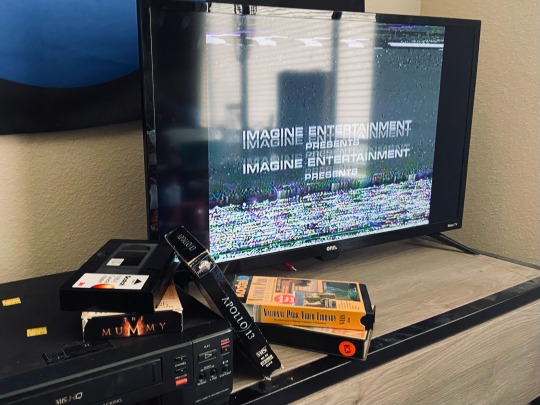
I know this is my art blog, but it has come to my attention that some of you are too young to have experienced the joys of the Video Home System in its prime. Come hither so I can teach you and we can embrace the beauty of physical media together. If you have a thrift store and a TV, this process should work for you.
Step 1: Get a VCR ($4-$15)
DO NOT BUY EXPENSIVE VCR/COMBO SETS FROM THE INTERNET!
The ones you find on sites like eBay and Etsy are insanely overpriced and might not even work. Instead, find a Goodwill, Savers, or independent thrift store near you and go to the electronics section. There’s a good chance they’ll have at least one VCR. If they don’t, try a different shop. You can also check local online marketplaces, yard sales, etc.
Good things to look for:
4 (or more) Heads — Heads are the things that actually read the tape. The more heads you have, the better your picture is going to be.
Auto Tracking — Poor tracking can create a rolling picture, which is a pain to fix. An auto tracking VCR does that work for you.
Pre-2000 — After 2000, electronics started being mass produced with plastic casings and cheap parts. VCRs made after this time are a whole lot easier to break. Ideally, you want something from the late 80s to mid 90s.
Well-known brands — Sony, Toshiba, etc. Japanese manufacturers tend to have the best quality. Early Emersons are nice too.
Generally good condition — If there’s a bullet hole in the case, it’s probably best to pass on. A bit of dust isn’t an issue, but major damage isn’t a good sign. If you can, plug the machine into a power outlet in the store and see if it even turns on.
Head cleaning indicator — Not something you *need*, but I find it nice to have. You’ll want to use a head cleaning tape when the indicator starts flashing.
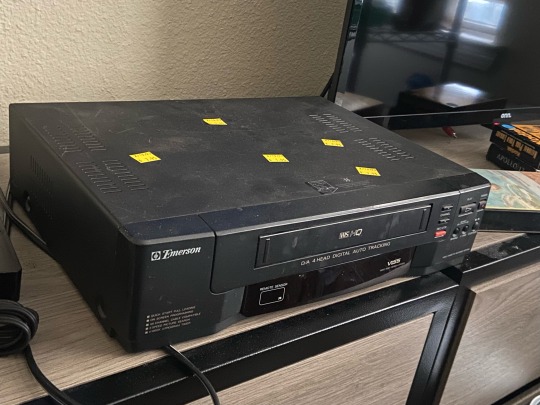
This is the one I’ll be using for the sake of this guide. This is an old Emerson that I picked up from Goodwill for $7.95. (Notice the five price tags they slapped on top.)
Step 2: Get Some Tapes (¢10-$1)
This is the fun part. Almost every thrift store will have some VHS tapes, usually near the books/DVDs/records. I’ve seen them as expensive as a dollar, but some stores will just give them away for free. I suggest buying a few movies you like, plus one or two shitty tapes to test out your VCR with.

You may also find 20 different copies of Titanic in every store. This is a normal occurance.
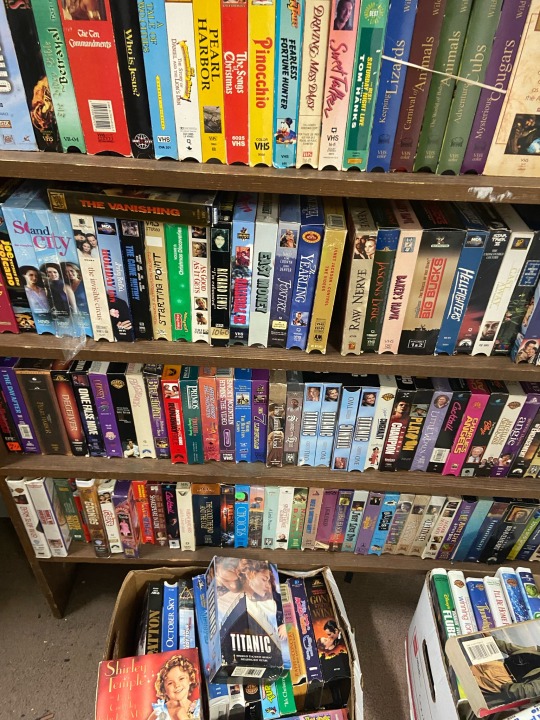
Remember to check the condition of any tape you plan on putting in your machine. If the spool looks moldy, you *can* try to clean it, but you’ll need another VCR to do so. If the tape looks wrinkled or otherwise damaged, you can still probably play it, but it will look and sound a lot rougher than you should expect. If the casing is damaged, I wouldn’t risk trying to put it in your VCR at all.
Remember: VHS tapes stopped being produced commercially in 2006. Most tapes you find aren’t going to be in the best shape, because they’re all a few decades old. (Sometimes, though, you will come across a tape with an excellent picture, good sound quality, and subtitles! The Mummy tape that I own is near perfect.)
Step 3: Connecting the VCR to Your TV
For this step, you’re going to want a coaxial cable and a set of RCA cables (the red, yellow, and white ones). If your TV doesn’t have an RCA input, you’ll also need an RCA-to-HDMI converter. If your TV also doesn’t have an HDMI input for whatever reason, you’re shit out of luck.
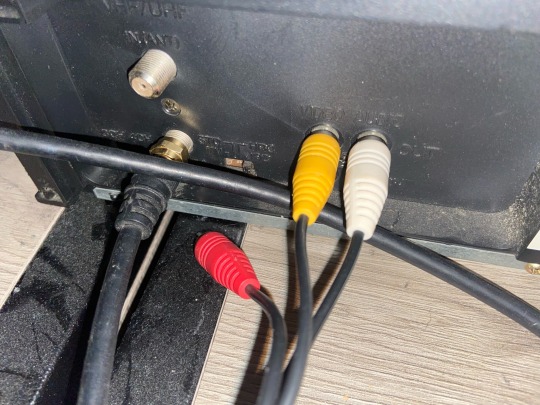
You’ll plug these cables into the “out” or “out to tv” connection on your VCR, then plug the other end into the back of your TV.
Note: Not all VCRs have right audio (the red one)! That’s fine. Just leave it hanging free. The left audio (white) is your mono audio, so you’ll just have that instead.
Lastly, put the channel switch on the back of your VCR on 3 or 4. I keep mine on 3. This is the number for the channel you’ll go to on your TV to actually see what the VCR is playing.
Step 4: Setting up the TV
I use a little Roku TV, which is surprisingly steady to set up for VCR input:
Settings ➡️ TV Inputs ➡️ Live TV
From here, you’ll either be prompted to scan for channels OR you’ll have to select “scan for antenna channels”. It will ask you if you want to have channels 3 and 4, to which you’ll say “yeah, I do want channels 3 and 4” and click the button that lets you have channels 3 and 4. If you don’t have an antenna, you can skip the other prompts.
I haven’t done this on any other type of TV, but the process should be pretty similar: get yourself to channels 3 and 4 through whatever means necessary.
Once you’re there, it should look like this. Sad, blank, and lonely. But not for long.
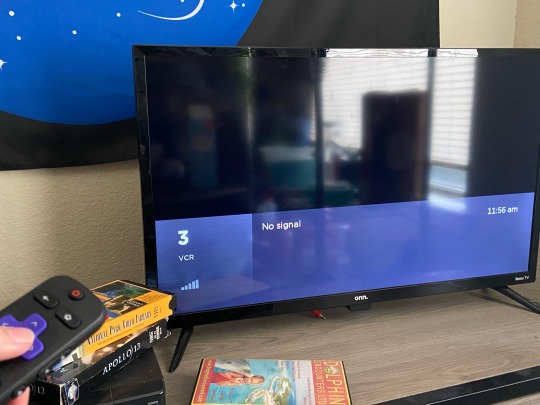
Step 5: Playing Your Tapes
This is where things can go really really well or really really wrong. If everything is hooked up, you can grab your shitty tape and insert it into the VCR.
(Make sure there isn’t anything else in there first, though. Some people don’t remove their precious Titanic copies before donating these things.)
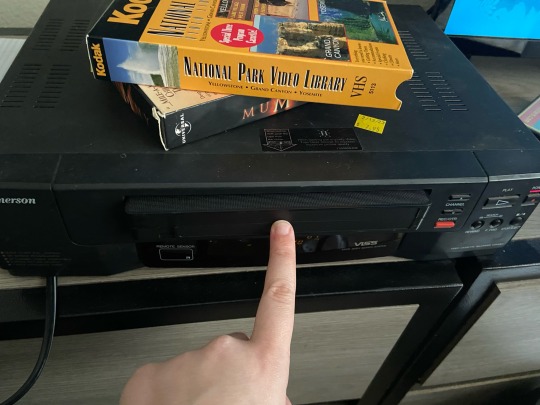
You’ll want a tape that’s fairly clean, with no casing damage, and already rewound (black tape in the left window). To insert the tape into a front-loading VCR, slowly and firmly slide it into the slot. Once it’s most of the way in, the machine should “grab” it and pull it all the way inside. You’ll hear the machine make some noises.
(If those noises are really crunchy, that’s probably not a good thing. Troubleshoot with your favorite search engine or head over to r/VHS to see if anyone can help you.)
Once your machine is only making some clunky whirring sounds, it should be safe to press the play button. Enjoy watching your favorite films in the least pleasant format possible. Don’t forget to rewind em when you’re done.
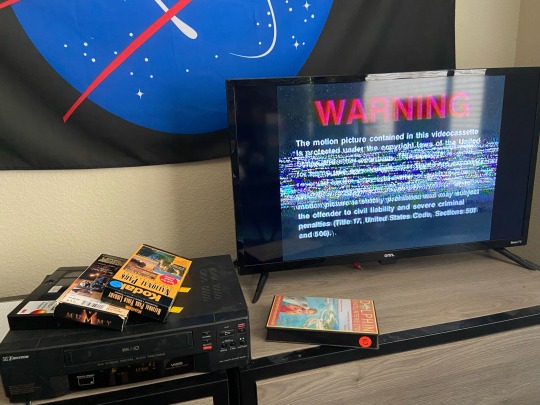
If you have issues, the freaks over at r/VHS tend to be really helpful, but you can also find decade-old YouTube videos that might answer your questions too.
183 notes
·
View notes
Text
Twin Famicom (NES model by Sharp)
The Twin Famicom is a video game console system that was produced by Sharp Corporation in 1986 (Juli 1) and was only released in Japan. It is a licensed Nintendo product that combines the Famicom (NES) and the Famicom Disk System into a single piece of hardware.
The essential parts of the Twin Famicom include a 60-pin socket for Famicom cartridges and a socket for Disk System disk cards. The player could switch between the two media types with a switch – cassette "カセット" or disk "ディスク" The Twin Famicom is fully compatible with the NES and can handle accessories made for the NES (e.g. Beam Gun). But there is also an extra port on the Twin Famicom. This allows a 'regular' Famicom to use the Twin Famicom's disk drive.

The original Famicom only has one color combination, and the Twin Famicom was initially sold in two colors: red with black highlights (AN-500R), and black with red highlights (AN-500B). A second version of the system was released in 1987 with a slightly different case design, turbo controllers, and two different color schemes; black with green highlights (AN-505-BK) and red with beige highlights (AN-505-RD).
Like the Famicom, the Twin Famicom uses NTSC but with an AV output rather than an RF modulator[2][3] with an RCA connector for composite video and mono audio, allowing for greater audiovisual quality on TVs and monitors with such inputs. An external RF modulator is bundled with the unit for connection through a TV's antenna/cable input. The two gamepads are hardwired into the console, so they cannot be disconnected. Source: Wiki NES models Check these out too if you are interested in retro computing








22 notes
·
View notes
Text
I just realized that I've had my home office speakers on the wrong side for over three years (I just recently upgraded my audio switcher for my speaker system to RCA red/white cables), so my stereo has been backward that whole time. 🫤
I guess now I listen to my favorite songs all over again to experience them anew.
5 notes
·
View notes
Text
today’s educational and demystifying post: How DO you connect a record player or turntable to a computer so you can rip vinyl?
Or for that matter, listen to records through your PC speakers. If this isn’t of interest to you, continue scrolling. If it is, click on thru to the other side...
Where does one get a thingie that plays records? You can go the cheap route and find one in a thriftstore, you can go the pricey route and buy one new, you can go the upper-mid-range route and find one at a used record store (at least you’re more certain than at a thrift that the thing will work!) -- or you can cheat the system a bit by buying one of those all-in-one record/tape/CD/radio setups that look like an old cabinet, branded with Crosley or Intelligent Technology or the like, and see what options it has for output (two RCA output jacks and/or a headphone jack), which often costs less than just a turntable alone.
Can we even do this? It’s fair to say that not every record player can be connected to anything at all if it has built-in speakers. Many, though, have a headphone jack that when plugged into will shut off the speakers, so that’s one way. Turntables meanwhile always have some way to connect to a stereo system, specifically the coaxial connectors known as RCA plugs, and occasionally have a headphone jack also. The RCA plugs are usually color coded red and white for the left and right channels, though nothing’s going to explode if you switch them. :) Here’s what the RCA plugs from a turntable look like next to the RCA input jacks on the back of my stereo receiver:
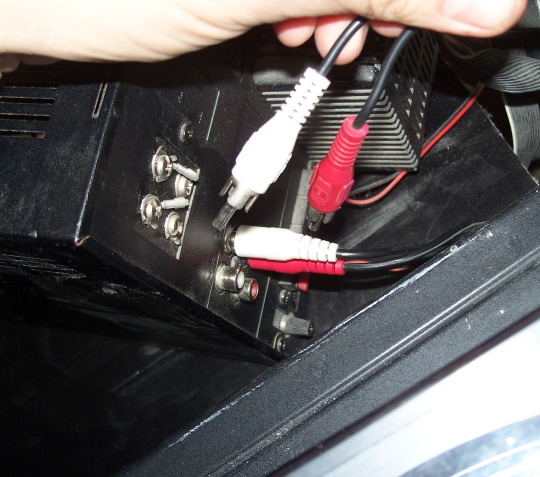
So how do I get the record player connected to my computer? Let’s look at the computer first... There’s a microphone jack on the computer, on the back or possibly you have a second one on the front of a desktop machine, or on a notebook there’s a jack on the side, and many are color-coded pink. (Additionally there may be a blue color-coded jack next to it labelled Line In. It does the same thing but at a different volume level and that’s what I use on my notebook because something’s wonky about my mike input.) Now let’s look at whatever you’re playing a record on... If it only has a headphone jack, you can use one of those plug-to-plug cables ($8 at Walmart, $1 at Dollar Tree) that have become popular for playing music from your cell phone or MP3 player through the Auxillary jack of your car’s radio. [left] If it has RCA plugs, there are handy adaptors (two styles are shown here) to shift from RCA jacks to a headphone plug. [right] 2-RCA-jacks-to-1/8″-stereo-plug adaptors are available online or you might find one at a thriftstore or electronics store like BestBuy.
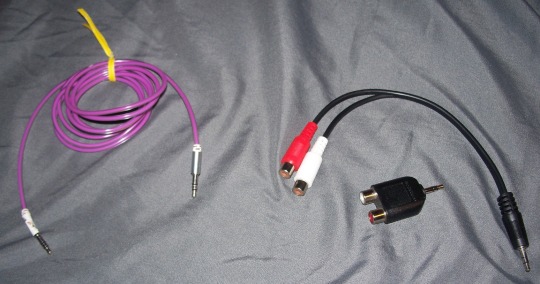
So plug the headphone cable into the record player’s headphone jack OR plug the two RCA plugs into the adaptor, and then stick the other end of the wire you’re holding into the computer’s microphone jack (or Line In). Now you are set!
(If you want to/can get a little more snazzy -- useful for adjusting volume and balance, the use of an equalizer, and some bonus effects like Bass Boost and Surround Sound -- here’s how I have my home setup: The turntable is connected to the RCA inputs on my stereo receiver, and I’ve run a cable from the receiver’s headphone jack to the computer’s input jack.)
Okay, so now what do I do on the computer? It’d take a longer post to explain every last detail fully, but you can shortcut past most of this by using the controls in the sound editor program Audacity, which you’ll probably want to be using anyway. (Nothing against any of its rivals like Magix Audio Cleaning Lab, which I also use for its various effects, but Audacity is very easy to understand for the process of ripping music from vinyl.) Let’s set Windows up to use the turntable as an input device now. In the latest version of Audacity, here’s the toolbar at the top:

First thing, choose the source (as shown). The above presumes that we’re using the frontside microphone jack on my computer; if the plug were in the backside Line In jack, that would be another option listed. Now we need to get the input sound level set. I’m going to put a record on and drop the needle in some random location; in the control buttons on the left I click Pause then click Record (just like a tape recorder!) so the input volume will be dynamically displayed without starting a recording:

The green ever-shifting bars in the input meter show that audio is coming into the sound card indeed, so that part was successful. Right in the middle (over the number 30) is the thumb for adjusting the input level -- if the bars weren’t going far on the scale, I’d move the thumb to the right to make it more sensitive, and if the bars were all the way to the right, I’d move the thumb to the left until the bars were maxing out between 6 and 12 on the scale, the yellow zone of the meter, because you don’t want it to be overloud (that’s called ‘clipping’; you can use the software to amplify not-loud-enough sound so being in the midrange is best). Once you have the input level corrected, now’s when you should adjust the output sound -- the standard Windows way, by clicking the speaker icon next to the clock to move the slider -- so you can hear it at your comfort level, and it doesn’t affect the volume of the audio files you create.
Okay, you can click the Stop button now that you have the input and output sound levels set, or you can restart the record where you want to begin and unpause. How to rip, edit, and save music is a different post. :)
What if I don’t hear what’s playing but Audacity shows the sound is working correctly? Also: Can I play vinyl and have the sound come through my PC speakers without being in a sound editor program? Input audio playing through the speakers is a function of Windows’ Sound control panel, the exact location of the toggle varies between versions, but here’s a screencap of what’s what in Windows 10:

Path here: Sound control panel, under Input the Microphone is selected so click Device Properties, then the window shifts to the Device Properties list; under Related Settings click Additional Device Properties, a new dialog pops up with four tabs, and under the Listen tab check “Listen to this device”. Also available here is the Levels tab, which is the place you’d be adjusting the recording level manually if you didn’t do it through Audacity as explained a minute ago.
A protip: It’s probably best to be listening through headphones, rather than using your computer’s speakers at normal volume, when ripping so you hear better sound quality as you work as well as so the playback sound doesn’t bleed/echo into the recording, because needles are fairly sensitive. Yes, I have an MP3 of Thompson Twins’ “Hold Me Now (Extended Version)” where you can hear me lean back in my creeky desk chair during a quiet passage...
So now you know how to physically set up a record player to your computer and how to get the computer to use the record player as an audio input!
66 notes
·
View notes
Text
currently I get audio to my speakers through an aux-rca adapter out of the 2nd headphone jack of my interface and I want to get proper cables so I can use like. the real outputs meant for speakers but they're like 1/4in two mono jacks and cables would be like. $30!!! not that much I know but it feels silly considering I only paid $50 for this interface...
24 notes
·
View notes
Text
when tumblr dies ill be popping off in the amazon reviews of
Seismic Audio Speakers 4 Channel RCA Audio Snake Cable, 20 Feet
4 notes
·
View notes
Text
This RCA Male Plug AV connector comes with screw terminal which ensures a firm and secure connection for audio and video signal cables. This RCA male connector is commonly used for CCTV installation and it only needs a screw driver to make secure connection for a variety of applications such as CCTV, microphone or camera installation.
2 notes
·
View notes
Text
a common fantasy among non-binary people is to acquire a significant windfall of chords, cables, and connectors. For example, one might daydream about a monoprice box arriving containing six HDMI chords, two RCA cables, a female to female Red and White audio adapter, a few toslink cables, a 5-pin USB-A to USB Micro B cable, and many other such opulences.
4 notes
·
View notes
Text
INTRODUCING THE FRÜGER CABLES PARTNER PORTAL COLLABORATION FOR ENHANCED EFFICIENCY

Früger Cables is excited to unveil our new Partner Portal, designed to streamline collaboration and communication with our valued partners. We understand the importance of seamless interactions and efficient processes, which is why we’ve developed this intuitive platform to enhance our partnership experience.
Key Features of the Früger Cables Partner Portal: Centralized Communication Hub: Our Partner Portal serves as a centralized communication hub where partners can easily access important updates, announcements, and resources. Whether it’s the latest product information, marketing materials, or training resources, everything you need is conveniently located in one place.
Instant Access to Sales and Marketing Tools: Partners can leverage a wide range of sales and marketing tools available on the portal to drive business growth. From product catalogs and price lists to customizable marketing materials and promotional campaigns, our portal provides instant access to resources that empower partners to succeed.
Efficient Order Management: The Partner Portal streamlines the order management process, allowing partners to place orders, track shipments, and manage inventory effortlessly. With real-time visibility into order status and inventory levels, partners can make informed decisions and ensure timely fulfillment of customer requests.
Training and Certification Programs: Früger Cables offers comprehensive training and certification programs through the Partner Portal to help partners enhance their product knowledge and sales expertise. Whether it’s product training modules, sales workshops, or certification exams, partners can access valuable educational resources to stay ahead of the curve.
Dedicated Support and Assistance: Our Partner Portal provides partners with access to dedicated support and assistance from our team of experts. Whether you have questions about products, pricing, or technical specifications, our support team is here to provide prompt assistance and ensure a seamless experience.
At Früger Cables, we are committed to fostering strong and collaborative relationships with our partners. With the launch of our Partner Portal, we aim to provide partners with the tools and resources they need to succeed in today’s competitive marketplace. Join us on this journey of partnership excellence and unlock new opportunities for growth and success.
ORIGINALLY FOUND ON- Source: Früger Cables & Accessories(https://fruger.de/introducing-the-fruger-cables-partner-portal-collaboration-for-enhanced-efficiency/)

1 note
·
View note
Text
Blind Review - Vizio 1080p 40” smartCast Smart Display (smartTV)
- by Bryan Gruver
Display
I am blind. My friend says it looks great. Vizio is known for good black levels. That is how black black actually is when it is displayed.
I called this a display and not really a TV because it is mainly a display. Technically, it does have a TV tuner built-in, but this TV really shines as a smart display. You can airplay to it from your Apple device or cast to it from your android device. Among its real inputs, it has several virtual inputs and buttons on the remote specifically for streaming services, including a free one. As far as inputs go, it has down facing Analog (Red White and Yellow RCA) inputs and side facing HDMI inputs, two. And an optical out below theHDMI ports. This makes the unit perfect for wall mounting. The coax input is also down facing. We use this input for an actual over the air digital antenna. I wish it had more HDMI ports. At least three. But this is fine for what we have. A cable box, and DVD player.
Audio
Out of the box the unit had no base. I left it like this because I intended to hook it up to a sound bar and bass usually just muddles The audio of cheap speakers. The mid range and high end is very good. At times you think it’s a real person in the other room. A virtual surround sound effect is enabled. It’s pretty good. Although I intend to replace the speakers with the sound bar, they are actually very decent quality.
As a Computer
Welcome to the future, everything is a computer. This TV is actually running googles Android. But for this purpose, it works well. You may have to occasionally fully reboot the TV. There is a way to do this in the menu. Otherwise, the TV will quick start. This means it’s in a low power mode. There is also an app for the TV that will allow you to fully control the TV, change settings, change inputs and a completely virtual remote. This is great for a blind person. Apple devices are very handicapped accessible,. this feature makes it very useful for me. You can also enable talk back on the accessibility menu in settings. I have not done this, but from what I know, it will speak the items on the screen.
Thoughts
I got this TV used from Amazon for $134. You would never know that it was used. This is a great deal. It is heavily subsidized. I am very happy with the quality overall, and Vizio as a company. I would recommend their products..
I am going to try something new. If you enjoyed this review and would like to tip me, please feel free to send cash to my cash tag. Lol. $brygruver
I am also going to include a link to my Facebook page where if you purchase through my link, I will receive a small commission, thank you.
- groovyBry $brygruver 👍📺💵

3 notes
·
View notes
Text
Got a free tv, got free speakers. They can't connect to each other due to having different cable connections (well... the tv has RCA cable input but not output, as a scam to get you to use their brand of speakers. The free speakers also have rca input, a normal thing for speakers to have)
I don't like this because it means I have to connect the speakers to my computer and the tv to my computer, and the speaker cable is too short that i can't comfortably sit in my chair and watch tv at the same time (the hdmi cord is long enough tho)
The only audio-out on the tv is an optical cable, i can't find an adapter cord online and decide to buy a long headphone cord to connect my computer to the speakers, irritated that i need a second 10ft line to connect two appliances that are inches apart
I kvetch to my brother, amazingly he had the same problem a week earlier because he wanted to connect his speakers to his projector instead of connecting both to his computer
He got an adapter box, it needs to be plugged in 🙄
It gets plugged in with usb, a connection neither the speakers or tv have
I use it to successfully connect my speakers to my tv! But the closest usb port is my computer
I went from needing my speakers and tv connected to my computer to the adapter box and the tv connected to my computer🙄🙄🙄
#i just need an extension cord so everything can be plugged into the wall and I'll only need to connect the tv to my computer#so all in all still cheaper than buying a tv & speakers#but it's rare i get into one step forward one step back sitcom nonsense like this#fortunately it's funny otherwise it wouldn't be worth how FRUSTRATING it is
2 notes
·
View notes